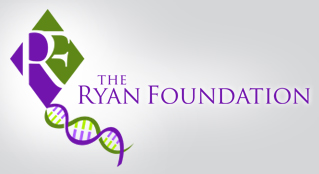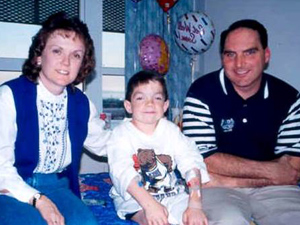
"Your child's disease is too rare to treat."
...we need your help so that moms and dads will never hear these words again.
Plain and simple, children with rare diseases are dying because they were born with an illness the majority of the world does not recognize. We need your help to stand with those children in the fight against rare disease. Frankly, the Ryan Foundation does not receive donations from large companies because the diseases we support are so rare. Your gift today will be used to fund specific science that will lead to treatment for these forgotten few.
Here is an example...
Look at the two pictures as they flash below... they are of the same young man, Ryan. The first photo was taken of Ryan when his parents knew that their nine year old son would be dying in a just few years. Look at Ryan now in the second photo. He is in his late 20s, happy, and forging ahead with life. Children like Ryan with MPS I are now being treated in 75 countries around the world. Here is why... donors like you gave personal gifts so that a treatment could be created for children like Ryan.


It can and will happen again with your support. It truly is the personal gift that keeps hope in the life of a child who suffers with rare disease. Please remember the Ryan Foundation has no paid staff so that your gift will go to find treatment and to improve the quality of life for those living with rare disease today.
CURES are possible but not without your help today.
The race against rare genetic diseases in children
Children with a Rare Disease are racing the clock from the moment they’re born. Imagine hearing the news as a parent that your child has a disease that will end their life in only a few short years. Now imagine being told little research for the disease exists because it wouldn’t generate enough profit for a drug company to pursue. It’s a literal race against time for your child, and disease has a huge head start. How do you get your child out of what seems a hopeless situation in a world where no one is even looking for a cure?
The Ryan Foundation exists to find, then fund researchers with novel science that can lead to actual treatment of Rare Disease; with a specific emphasis on Mucopolysaccharidosis (MPS) and other Lysosomal Storage Disease (LSD). The Ryan Foundation works hand-in-hand with National and State legislators to build a stronger partnership between government, research science, and the individuals and families living life with MPS and all Rare Disease. The goal of the Ryan Foundation is to secure a better future for both the families living with the pain of Rare Diseases today as well as tomorrow's generations.
What are rare diseases?
A rare disease is any disease or medical condition so rare in occurrence it receives little or no research as to its cause or cure. Rare Diseases, as defined by the US Congress and FDA, are diseases which affect less than 200,000 US citizens. Yet, if you add up all the people who have one of the more than 6,800 rare diseases, the total raises to over 25 million Americans. Only 200 of those illnesses currently have any treatment option. The fact that 30 percent of children who contract a rare disease will die before reaching the age of five years old is undisputed.
According to the Global Genes Project, Rare and genetic diseases affect 1 in 10 Americans, 30 million people in the United States, and 300 million people globally. Over 7,000 distinct rare diseases exist and approximately 80 percent are caused by faulty genes. The National Institutes of Health estimates that 50% of people affected by rare diseases are children, making rare diseases one of the most deadly and debilitating for children worldwide.
While individual rare diseases have small patient populations, collectively the rare disease community is larger than the AIDS and Cancer communities combined. Despite its size, the community lacks of a unified voice, as only 15% of rare diseases have organizations or foundations providing support or driving research.
It is estimated that 95% of all rare diseases do not have a single FDA approved drug treatment, and there are currently less than 400 treatments approved by the FDA for the nearly 7000 rare diseases which have been identified. According to estimates from the NIH, it will take 10,000 years at the current rate of FDA drug approvals to find therapies for all people suffering from rare and genetic diseases.
Facts about rare diseases
Although rare and genetic diseases, and many times the symptoms, are uncommon to most doctors, rare diseases as a whole represent a large medical challenge. Combine this with the lack of financial or market incentives to treat or cure rare diseases, and you have a serious public health problem.
Here are a few rare disease facts and statistics to illustrate the breadth of the rare disease problem worldwide.
- There are approximately 7,000 different types of rare diseases and disorders, with more being discovered each day.
- 30 million people in the United States are living with rare diseases. This equates to 1 in 10 Americans or 10% of the U.S. population.
- Similar to the United States, Europe has approximately 30 million people living with rare diseases. It is estimated that 350 million people worldwide suffer from rare diseases.
- If all of the people with rare diseases lived in one country, it would be the world’s 3rd most populated country.
- In the United States, a condition is considered “rare” it affects fewer than 200,000 persons combined in a particular rare disease group. International definitions on rare diseases vary. For example in the UK, a disease is considered rare if it affects fewer than 50,000 citizens per disease.
- 80% of rare diseases are genetic in origin, and thus are present throughout a person’s life, even if symptoms do not immediately appear.
- Approximately 50% of the people affected by rare diseases are children.
- 30% of children with rare disease will not live to see their 5th birthday.
- Rare diseases are responsible for 35% of deaths in the first year of life.
- The prevalence distribution of rare diseases is skewed – 80% of all rare disease patients are affected by approximately 350 rare diseases.
- According to the Kakkis EveryLife Foundation, 95% of rare diseases have not one single FDA approved drug treatment.
- During the first 25 years of the Orphan Drug Act (passed in 1983), only 326 new drugs were approved by the FDA and brought to market for all rare disease patients combined.
- According to the National Institutes of Health Office of Rare Disease Research, approximately 6% of the inquiries made to the Genetic and Rare Disease Information Center (GARD) are in reference to an undiagnosed disease.
- Approximately 50% of rare diseases do not have a disease specific foundation supporting or researching their rare disease.